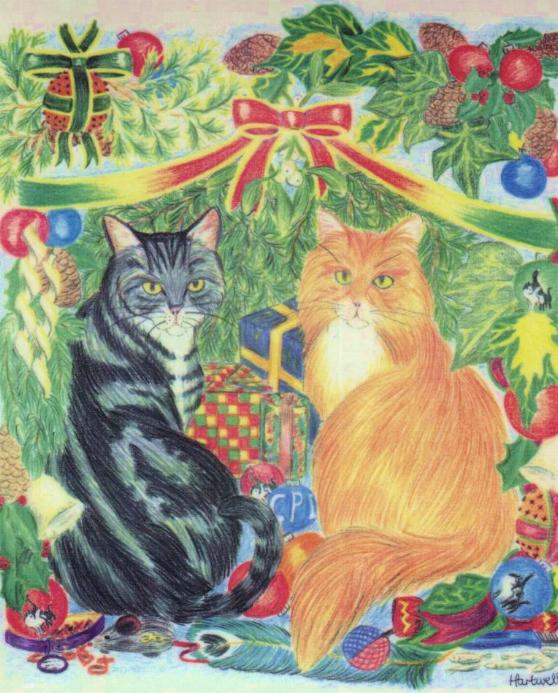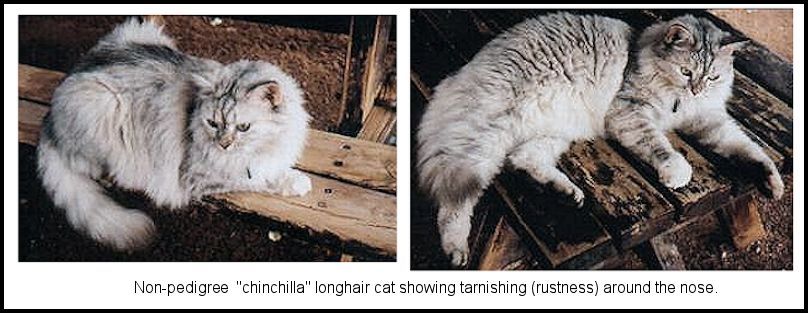
INHIBITOR GENE: SILVER AND GOLD: SMOKE, SHADED AND TIPPED CATS
This article looks at the history and genetics of the silver and golden cats. There are many terms used to describe the different smoke, shaded and tipped cats and these are different depending on whether a cat is longhaired or shorthaired! Some terms are now only found in older books, so I've included the various alternative names. The first section explains the different patterns and a little of their history. The second section explains the genetics, including disproved theories you may come across elsewhere (even disproved theories come back to haunt breeders!).

SOME BASICS
First some very basic genetics! The difference between chinchilla/tipped, shaded silver and silver tabby are largely due to the underlying tabby pattern (ticked, mackerel/spotted or classic). Tabby patterns are cause by genes at two different places. The agouti gene, A, allows the hairs to be banded with alternate light and dark bands. The recessive form, non-agouti "a", means the hair is solid colour without lighter bands. In cats with the Agouti version (allele), the actual pattern is due to a different gene. There are three identified alleles of the tabby gene. Ticked tabby (Ta) is on one allele while the tabby patterns are on a different allele. Mackerel (Mc) is dominant over blotched (mc).
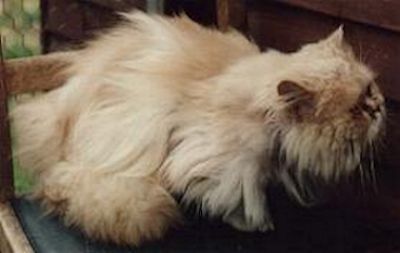
Smoke, shaded and tipped patterns are due to the Inhibitor gene (silver-restriction). This gene allows pigment at the tip of the hair, but restricts the amount laid down on the hair shaft, so that the shaft is either white/ivory (silver series) or golden (golden series). Tipping/shading causes the normally yellow-brown agouti band to be both lighter in colour and wider, starting closer to the root and ending nearer the hair tip than in tabby cats. The width of the light band is influenced by polygenes, collectively called "wide band." The tipping colour is known as the top-colour, while the pale colour of the hair shaft is known as the undercolour. These patterns are most striking on the eumelanistic colours (black, blue, chocolate, cinnamon, lilac), because of the contrast between pattern/top-colour and the background/undercolour. Shading and silver also occurs in reds and creams which are sometimes termed cameos.
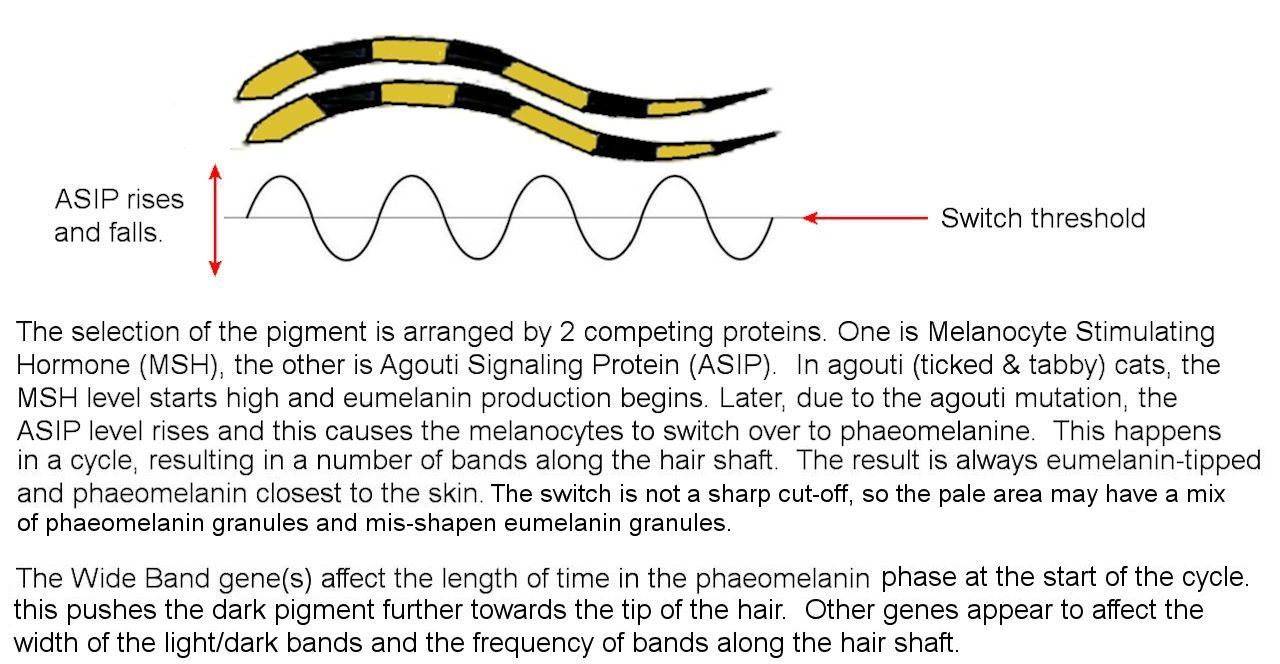
Sometimes the Inhibitor gene fails to completely block pigment (it is more effective at blocking black-based pigment than blocking red-based pigment) and there is a breakthrough of reddish colour known as "tarnishing". Tarnishing is common on the muzzles of random bred silver tabbies, but rare on pedigree silver tabbies due to selective breeding and refinement.
Tipping is not restricted to black. It can occur in any of the black-based and red-based colours and in tortoiseshell and tortoiseshell-tabby. The naming convention is given in the table below. In red-based colours, the term "shell" was used to describe the cat having a shell of colour rather than a solid (to-the-roots) colour. "Cameo" described the type of red - similar to the colour of old cameo necklaces - with "Cream Cameo" (pictured here) simply meaning a paler form of this. The introduction (or re-introduction) of the red series also introduced tortoiseshells.
In addition to the dominant Inhibitor gene (not present in the Golden series), a good quality silver cat also has a separately inherited Wide Band effect. For convenience, breeders talk of Wide Band as a single gene, but there appear to be multiple interacting genes that determine the width of the pale band between the pigmented tip and the follicle. The presence or absence of the Inhibitor (silver) gene does not affect the Wide Band effect - Golden Shadeds lack the Inhibitor gene, but have a shading pattern comparable to Silver Shaded cats.
Non-agouti + Wide Band = Solid Colour
Non-agouti + Wide Band + dominant Silver = Smoke Pattern
Agouti + Wide Band = Golden series
Agouti + Wide Band + dominant Silver = Silver series
Additional genes influence banding frequency, band width and band placement on the hairs. An ideal Shaded Silver hair has a single broad band of pigment at the tip of each hair. In life, Shaded Silvers have a mix of three patterns: a single broad band and wide undercoat; a few broad bands and wide undercoat or multiple thin bands (as seen in the background colour of Silver Tabbies). The criteria for each degree of tipping is an ideal and there are many cats that visually fall between two ideals.
In goldens, wide band refers to the yellow banding of the hair shaft. A eumelanin series cat (black/brown) can be homozygous for Wide Band and have no Inhibitor gene (or have the recessive form or inhibitor) making it Golden, so the undercoat is warm cream or apricot. For that reason, it's suggested that some poor quality silvers were really pale creamy goldens.
Naming Conventions for Silver & Golden Series
.DESCRIPTION OF SILVER AND GOLDEN COLOURS
Chinchilla, or Tipped (Shell)
This is the lightest degree of tipping. Only the hair tip is coloured while the hair shaft is silver. Chinchilla Longhairs (Persians) have been around since the late 1800s and the pattern has been refined over many decades so that the underlying tabby pattern is diffused. Ticked tabby Persians exist, but most registries don t recognised the pattern and some breeders believe that a ticked tabby Persian is a sign of outcrossing to Exotic Shorthairs (which not all registries permit). The founding mother of Chinchilla longhairs may have been a weakly marked silver mackerel or spotted tabby longhair and breeders have selected for minimal markings ever since. Most other tipped cats cats are ticked tabbies (usually) with the inhibitor and a greater degree of wide-band. These cats have a sparkling appearance.
The Chinchilla Persian (Silver Chinchilla) has black tipped fur on a white undercolour. In non-Persian cats, the pattern is known as "tipped" or "shell". The best known shorthaired tipped cat is the Burmilla, which is part of the Asian group. Because tipped cats are genetically tabby, faint tabby markings can sometimes be seen on the face and limbs of kittens. These should have pink nose leather with a dark nose-liner and also dark eye-liner. They should have turquoise or greenish eyes - the eye colour is actually independent of the tipped pattern and was fixed by early breeders.
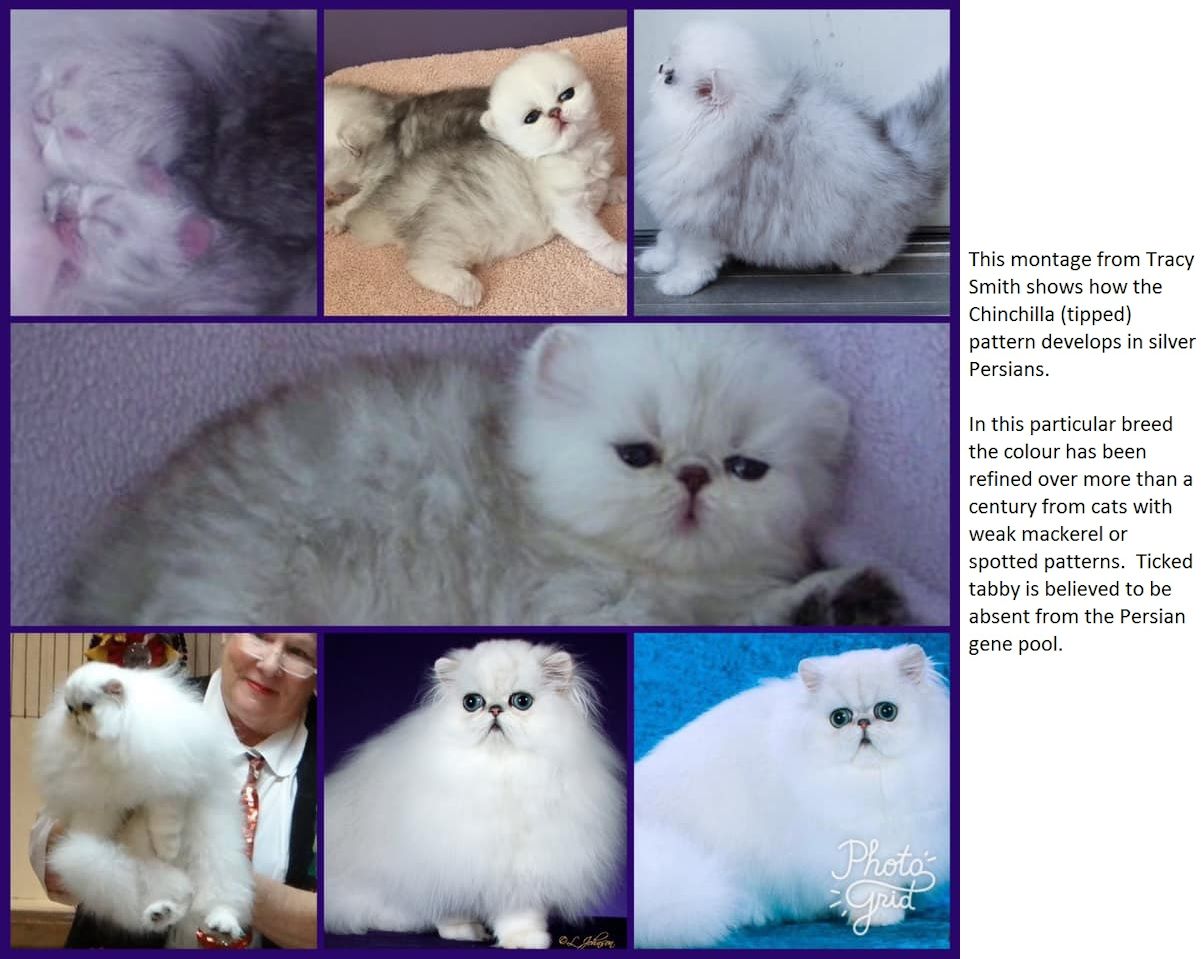
Selective breeding means tipped is due to the dominant Inhibitor gene + dominant Agouti gene and often + ticked tabby gene. Because ticked tabby is dominant over mackerel and classic patterns, tipped cats may also carry one of those recessive patterns. The ticked tabby gene is not completely dominant - sometimes the underlying tabby pattern is discernible on tipped kittens until the hair grows long enough for the white undercolour to be properly developed. As the hairs become longer, any breakthrough tabby pattern is diffused and only the very tips of the hair are coloured, producing a sparkling effect.
The Chinchilla's sparkling looks mean it is often associated with luxury, quality and class; Chinchillas are therefore used in advertising products that want to appear a cut above the rest; anything from luxury carpets to gourmet cat food and even household deodorisers. Golden Chinchilla/tipped cats have more of a pale honey-colour undercoat.
|
|
I (Inhibitor) |
i (i+) (non inhibitor) |
|
I (Inhibitor) |
II |
Ii (Ii+) |
|
i (i+) (recessive inhibitor) |
Ii (Ii+) |
ii (i+i+) |
Shaded
The next degree of tipping is known as "shaded". These cats are tabbies with diffused markings + inhibitor + lesser degree of wide-band. They may be ticked tabby or may have a diffused classic or mackerel pattern. The colour extends about half way down the hair shaft. The colour is darkest on the back, creating a mantle of shading, hence the historical term "mantled silver." Shaded silvers are the "black" form; but the shading can any colour. Shaded Golden cats have a pale honey-colour undercoat instead of silvery white.
Shaded Silver lies between the extremes of Silver Tabby and Chinchilla/tipped and is commonly produced by mating a Silver Tabby to a Chinchilla/tipped cat. The amount of tipping is variable, ranging from a poorly-defined Silver Tabby through dark- and light-shaded cats to a dark Chinchilla/tipped. Show standards set out clear definitions of the degree of colour permitted on a show-quality shaded silver. These should have pink nose leather with darker nose-liner and with dark eye-liner. They have turquoise or greenish eyes, again due to selective breeding for eye colour.
Pewter
Pewter cats have the same fur colour as shaded silver, but have orange eyes and are still uncommon. In the early days of breeding silvers, orange-eyed cats were preferred, but these eventually lost out to the green-eyed cats. Orange-eyed Shaded Silvers still appeared and to differentiate them from the green-eyed shaded silvers, they were called Pewters or Pewter Tipped. Some of the earliest Pewters may have been genetically blue (grey) rather than black or may have been light Smokes. The modern Pewter has heavier tipping than the Shaded Silver resulting in a darker mantle. The first modern Pewters were bred in the 1970s and exhibited as "Any Other Colour" alongside Shaded cats of then unrecognised colours such as Chocolate Shaded and Lilac Shaded. The Black Pewter gained Championship Status in 1986 in the UK. Still considered by some to be a poor relation of the Shaded Silver, the Pewter remains comparatively rare.
Those with a sense of history are pleased to see the ancestral eye-colour being bred again. Blue Pewters have also been recognised. The term Pewter Tabby was used historically to describe the Blue Silver Tabby.
Silver Tabby
Silver tabbies are spotted, mackerel or classic tabby cats with the inhibitor gene and wide-band. The inhibitor and wide band only affect the ticked hairs of the background colour. Silver tabbies occur in all patterned tabbies; these are described in Striped and Spotted Cats. Golden tabbies also occur. Silver tabbies in the random breeding population are prone to tarnishing - the appearance of a yellowish or rusty hue.
Silver tabby is caused by the dominant Inhibitor gene + dominant Agouti gene + one of the tabby pattern genes i.e. classic or mackerel/spotted and also occurs in combination with rosetted, marble and spotted patterns in Bengal and other hybrid breeds. This gives a silvery background colour with a tabby pattern overlaid on it. The Inhibitor gene only affects the agouti hairs, not the solid hairs of the patterned areas. In longhairs, the silver pattern is somewhat diffused by the hair length although residual striping may be seen on the legs and face.
|
|
|
The best known silver tabbies are the shorthaired black versions (black pattern on silver background) popular in advertising and known simply as Silver Tabby. A show-quality silver tabby will not have any "tarnishing" (yellowish tints, particularly on the muzzle). Other silver tabbies are prefixed by the name of the marking colour e.g. Blue Silver Tabby. So-called Pewter Tabbies are now more correctly known as Blue Silver Tabbies. In the red series, there are Red Silver Tabbies (Cameo Tabbies) and Cream Silver Tabbies (Cream Cameo Tabbies) with red markings or cream markings on a silvery background. There are also Tortoiseshell Silver tabbies.
The growing popularity of the Chinchilla Persian was at the expense of the silver tabbies. In 1951, Soderberg wrote "Silvers - this breed has almost disappeared, and at the present time there are only very few breeders who are attempting to bring it back to the popularity which it possessed at the beginning of the century [. . .] Although the Silver Tabby is definitely one of the neglected breeds, it would be a thousand pities if it were allowed to sink into oblivion."
Silver Ticked Tabby
The Inhibitor gene has also been introduced into Abyssinians and Somalis to create silver-undercoated varieties of ticked tabby. The main difference between silver ticked tabbies and tipped cats is the amount of Wide Band. Silver ticked tabbies are darker on the back and the outsides of the legs, but paler on the underside and inner legs. There is a clear horizontal division between the dark dorsl area nad the paler underside. Tipped cats have the colour restricted to the very ends of the fur. Again, golden versions also exist.
Smoke
Smoke is heaviest degree of marking in silver cats. Unlike tipped and shaded cats, smoke cats are genetically solid (non-agouti) colour, not tabby, cats. The pale undercolour is reduced to a small band near the hair root. A smoke longhair often appears to be solid coloured with a pale ruff or frill. In shorthairs, smoke varieties appear solid colour until the coat is parted or the cat is in motion, exposing the undercolour. The width of the silver undercolour is variable, resulting in lighter and darker smokes, but show standards set out clear definitions of the degree of colour permitted on a show-quality smokes. Smoke cats have coloured nose leather. Golden smokes do not exist because non-agouti + non-inhibitor gives a solid colour cat.
Smoke Persians were described in the 1860s and were believed to result from matings between blacks, blues and whites. In 1872, Harrison Weir described one smoke as "a beauty was shown at Brighton, which was white with black tips to the hair, the white being scarcely visible unless the hair was parted." In Britain, dark Smokes were preferred, while American cat fanciers preferred lighter colour cats. At first, only black smokes were recognised. Because of recessive genes, blue smokes occurred but were considered to be poor quality black smokes.
Smoke is caused by the combination of the dominant Inhibitor gene with the recessive Non-agouti (non-tabby) gene. The Inhibitor gene produces a pale undercolour. The extent of this undercolour is variable and the smoke can be described as light, medium or dark depending on the amount of top-colour, called "veiling," and how far the pale undercolour extends along the hair shaft. In smoke cats, the undercolour varies from almost white to a bluish grey. Cats with darker undercolours, or very narrow pale bands, may look self coloured.
Some Smokes can be so light in colour that they resemble Shaded cats. However, true Shaded cats are genetically tabby. A "poor smoke" must never be registered as a "shaded" because they are genetically different! Some smokes, known as overlaps, never develop the silvery undercoat and only prove to be genetically smokes when bred. Cat fancy standards define the ideal amount of veiling for an exhibition quality smoke. The variation is probably due to modifier genes.
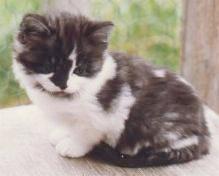 Smoke kittens sometimes show faint tabby markings, as seen in the photo on this page. Young smoke Persians look almost solid in colour except for a silver tracery (clown lines) where the agouti areas would appear in a tabby. Those that have clown lines tend to develop more striking adult coats, but in adults, clown lines are penalised. Smokes can occur in any black-based or red-based colours. Black, blue and red are the longest established and best known varieties. The Red (Cameo) Smoke has red/orange tipping on a whitish undercolour. Because of the way in which red colour is inherited (Tortoiseshell and Tricolour Cats), the males are red, but the females may be either red or tortoiseshell.
Smoke kittens sometimes show faint tabby markings, as seen in the photo on this page. Young smoke Persians look almost solid in colour except for a silver tracery (clown lines) where the agouti areas would appear in a tabby. Those that have clown lines tend to develop more striking adult coats, but in adults, clown lines are penalised. Smokes can occur in any black-based or red-based colours. Black, blue and red are the longest established and best known varieties. The Red (Cameo) Smoke has red/orange tipping on a whitish undercolour. Because of the way in which red colour is inherited (Tortoiseshell and Tricolour Cats), the males are red, but the females may be either red or tortoiseshell.
The non-agouti gene does not affect the red colour as it is produced by a different pigment (phaeomelanin). The difference in appearance between Red Smokes, Red Shaded Silvers and Red Chinchillas is not due to the cats having the agouti or non-agouti gene as it is with the other colours; it appears to be due to the Wide Band effect. However, the Agouti/non-agoutio gene affects the eumelanin (black-based) colours which makes a difference in whether the non-red areas of tortoiseshells turn out as smoke (Non-agouti) or as silver tabby (agouti).
Shorthaired solid colour cats tend to have ghost tabby markings which are particularly visible in kittens. Hence Smoke shorthairs may appear to be Smoke tabbies. The Black Smoke Egyptian Mau has been selectively bred to have visible spots on a Smoke background. According to Phyllis Lauder's book "The British, European and American Shorthair Cat" (1981), the Smoke factor can turn up in unexpected places. Lauder had a Blue Cornish Rex with underfur of the ash-white colour proper to a Smoke. When the cat was 2 years old, she noticed that the fur behind his ears looked silver. At the time, he could not be described as Smoke according to the standards for that colour (which demanded a light silver frill; and ear tufts and an ash-white undercoat tipped with blue), but he was nevertheless a Blue Smoke. The appearance of the smoke factor was not always welcomed by breeders. In particular, there were complaints that Red and Cream longhairs showed an undesirable degree of white in the undercoat.
Variable Expression in Smoke Cats
The inhibitor gene has a variable effect, probably due to polygenes. The photos provided by Sara Beaudoin at first look like a shaded silver, but a closer look shows him to be a black smoke i.e. non-agouti with extreme widebanding. The solid colour nose is indicative of non-agouti and this was confirmed by DNA testing. (The classification of smoke and shaded silver varies between registries. In some, such as CFA, chinchilla, shaded and smoke only refer to the length of tipping, not whether the cat is agouti or non-agouti. Being so far from the standard from smoke, this cat is black shaded silver, though that colour is not recognized in any major association.
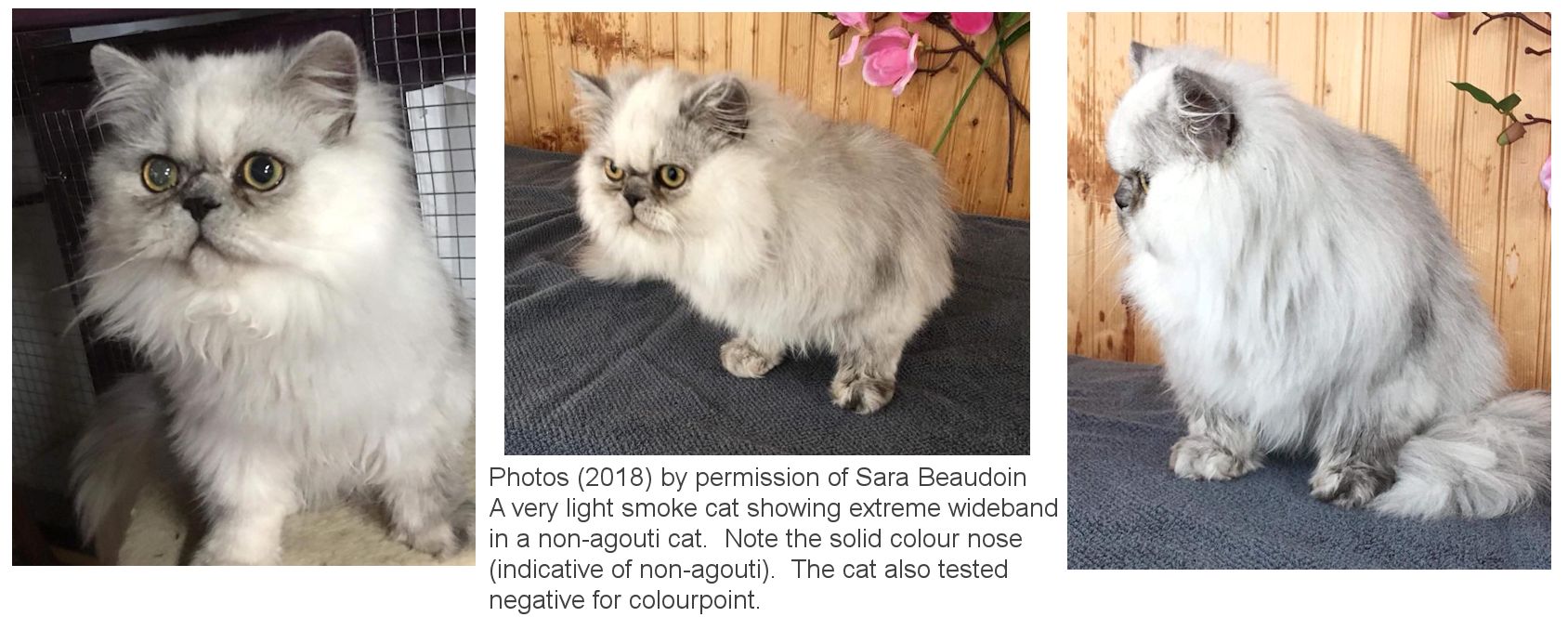
Below are three non-agouti silver Persians (non-agouti + inhibitor) and it is hard to differentiate between the amount of colour. According to CFA they are shell cameo [=red chinchilla], shaded cameo [=red shaded silver] and red smoke [i.e. non-agouti].
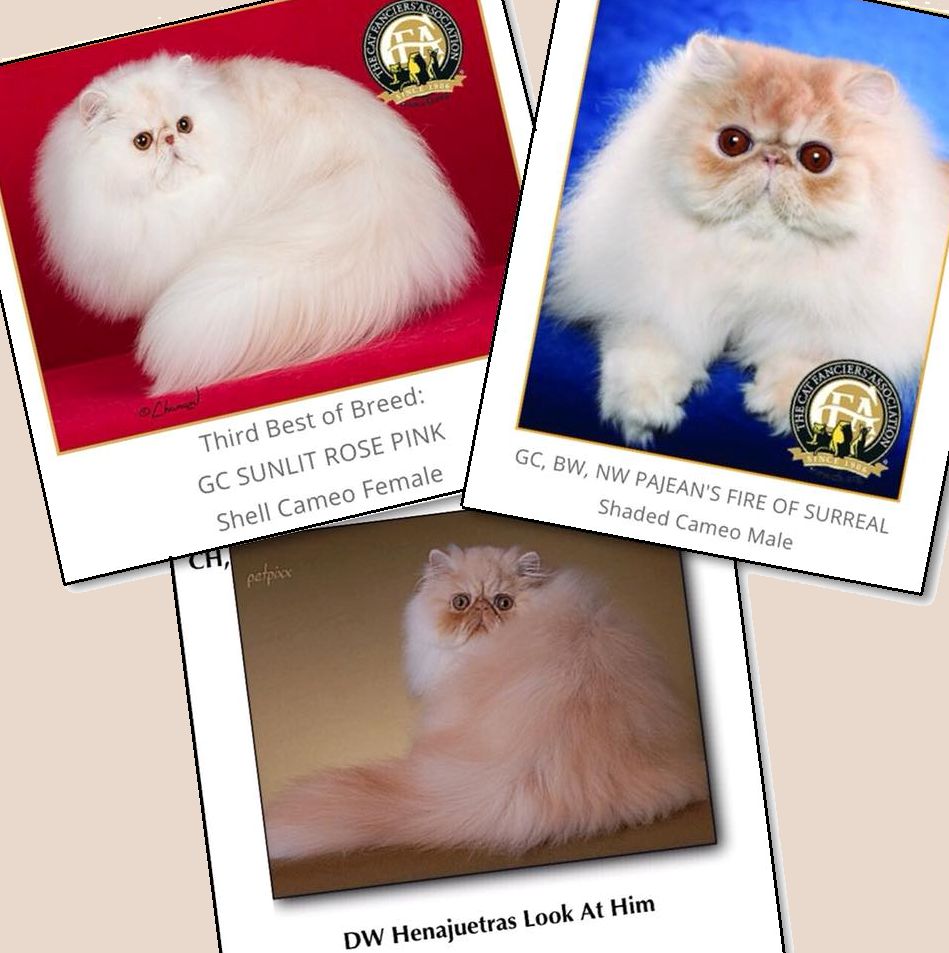
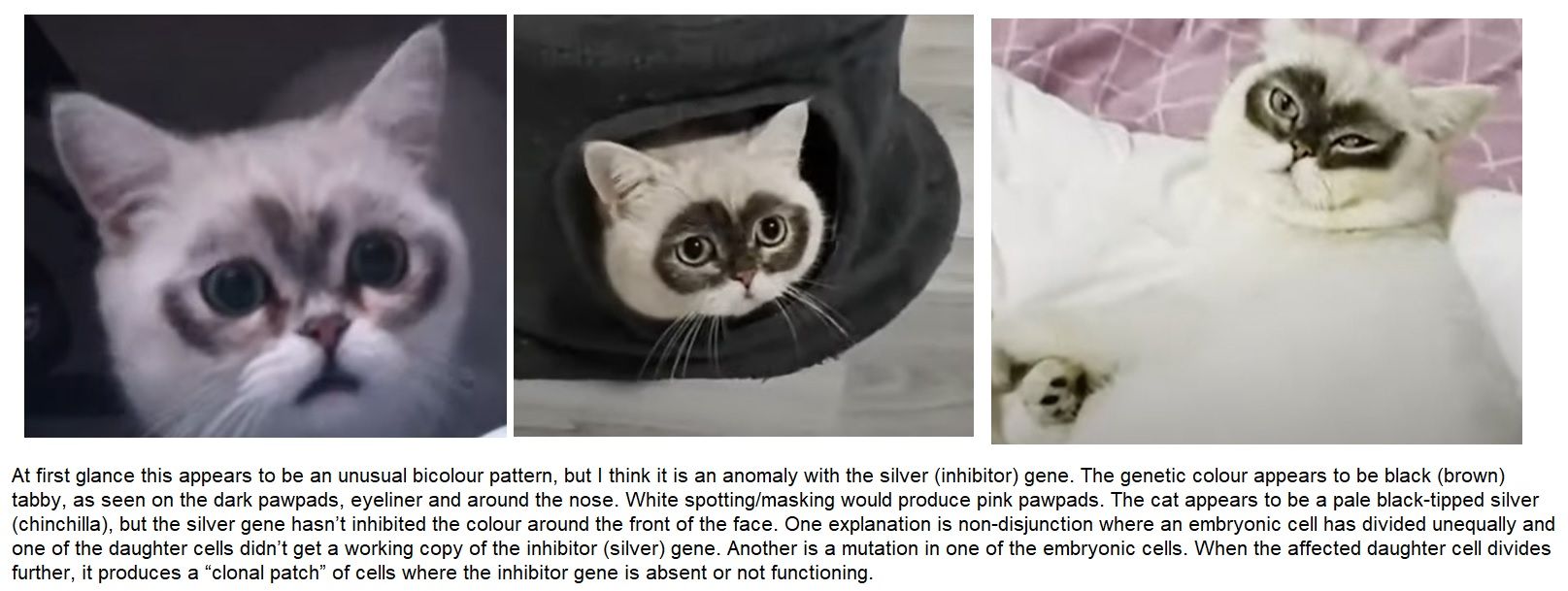
Masked Silver
These resemble the Shaded Silver except for the dark mask and dark legs. This was regarded as either a "light" Black Smoke or a sub-type of Shaded Silver. Several Masked Silver Persians were bred from Shaded Silvers. They differed from shaded silvers because on the face and legs the top-colour extended further along the hair shaft. The pattern did not breed true and the Masked Silver died out. Many kittens that initially appear to be Masked Silvers are actually solid colour cats with "fever coat" (a grey or mottled coat caused by the warm temperatures in the womb) and lose their pale coat at the first moult.
In 1926, Lord Sylvester, a curious cat ("a mixture of colours") won the Any Other Colour class and is considered to be a Masked Silver; he was shaded silver with a dark face. According to Milo Denlinger in 1947, "Masked silvers are a new variety and very few are bred. The ideal masked silver is a very beautiful animal; in colouring or, I should say, marking, they should resemble the Siamese Cat; that is to say, they should have a black mask, or face, black feet, and legs. The body should be as pale a silver as possible." The eyes were to be deep golden or copper. The Masked Silver was also described by Mery and others in the 1960s.
Martine Sansoucy of Butterpaws LaPerms has seen several masked silvers that appear to be smokes (non-agouti), for example Butterpaws BC The Crow, known as "Cairo" is a black smoke that meets the general description of a masked silver. This colour was retained throughout adulthood. The photo shows how the different textures of fur on the face and the body give the impression of a black-masked cat.
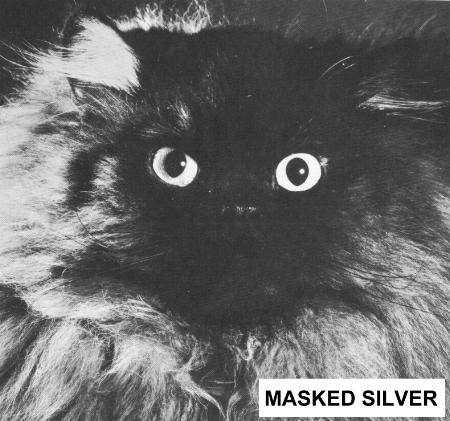 Historical Masked Silver. |
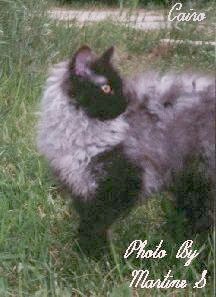 Masked Silver (black smoke) LaPerm. |
Grizzle
There is a form of tipped fur found in the Chausie, a breed derived from hybridising F chaus (Jungle Cat) with the domestic cat. Black Chausies with silver tipped fur (grizzle) occur; this is looks like a reversed chinchilla, but appears to be a form of black agouti inherited from F chaus.
Golden
Breeders have selectively bred for very pale chinchillas. Because Inhibitor and Wide Band go hand-in-hand, some cats inherit Wide Band but no Inhibitor (or inherit the recessive form of Inhibitor). This creates the Golden series. Without the dominant Inhibitor (silver) gene, the Wide Band effect produces golden chinchillas and shaded goldens. Golden tabbies are different from other tabbies, being brighter in colour due to wider colour bands on the hair shaft due to the wideband effect.
This theory is shown below; the "silver agouti" means a tipped or shaded cat. The Wide Band effect is necessary to widen the pale areas of the agouti hairs. Because smoke cats are non-agouti, a "golden smoke" is impossible. The naming convention is fairly standardised hence [colour-name] indicates the tipping/shading colour e.g. Blue Shaded Golden, Tortoiseshell Golden Chinchilla. Where a cat is described with no addition "colour-name" the tipping/shading/tabby etc is assumed to be black. The Golden Tabby is equivalent to the Silver Tabby with distinct markings on a golden background.
Golden series cats are different from other tabbies, being much brighter in colour due to wider colour bands on the hair shaft. The hairs are almost wholly golden with a darker tip and a pale or greyish undercolour near the base of the hair. The "Wide Band" effect brightens brown tabbies to golden tabbies and brightens shaded cats to chinchilla (tipped) cats. The presence or absence of the Inhibitor gene does not affect Wide Band; Golden Shadeds lack the Inhibitor gene, but have a shading pattern comparable to Shaded Silvers.
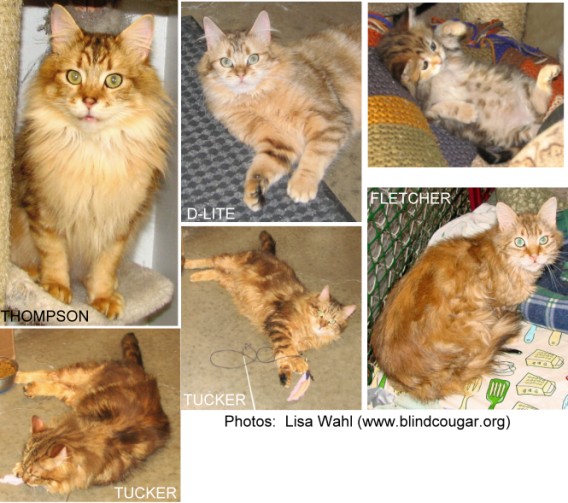
These photos from Lisa Wahl (www.blindcougar.org) show golden tabbies. Some have red markings and others have brown markings, but the background colour is bright golden. The cats came from a breeder who had died, leaving behind a line of golden "Maine Coon type" cats she had developed from barn cats, plus extensive breeding records. Some of the 50 cats rescued have very red undersides, and black paw pads.
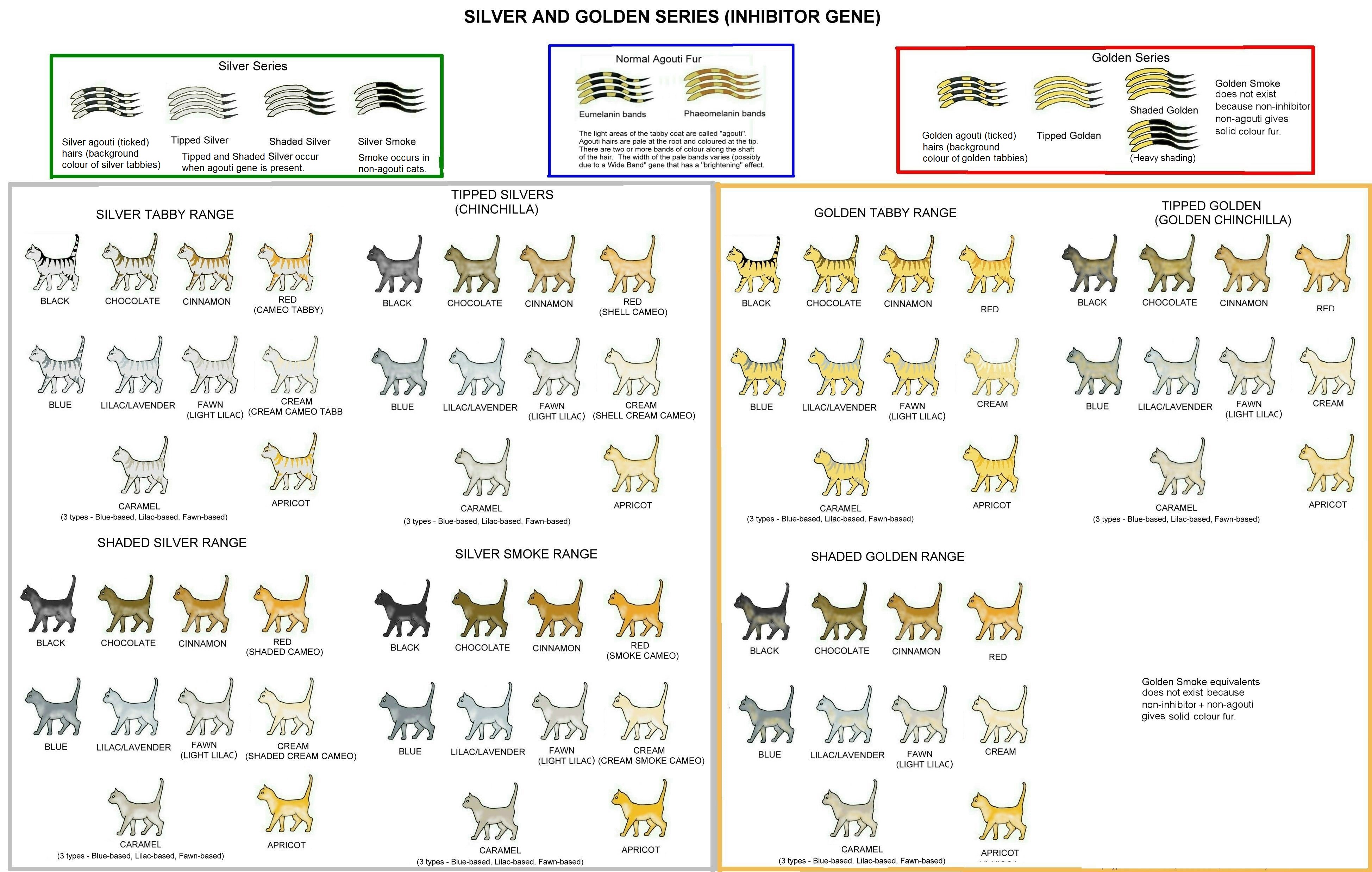
A HISTORY OF EARLY "SILVER" CATS
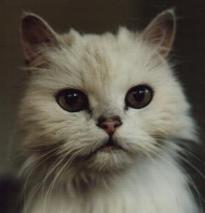 Old-Style Chinchilla |
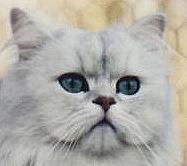 Modern Chinchilla |
At the British National Cat Show in 1879, one entrant was described as "a strangely graduated grey" which suggests it was a Shaded Silver. Early Chinchilla ("Self Silver") and Shaded Silver cats were derived from silver tabbies and were less well differentiated than their modern counterparts. Some early Chinchillas were poorly defined Shaded Silvers while others had distinct tabby markings.
The origin of the Chinchilla Persian was a female cat called Chinnie, born in 1882 when Silver Tabbies and Black Smokes were already familiar. Chinnie may have been a Silver Mackerel or Spotted Tabby Longhair with weak markings diffused by her long hair. Her weak markings would be considered heavy by modern standards. Her exact ancestry is unknown though it includes prize winning grandparents on one side and a stray tomcat on the other. She was unusual enough for interested parties to want to breed similar cats from her. She was mated to Fluffy I, a prize-winner of unknown parentage, who was a "very pure Silver with undecided tabby markings" (probably Chinchilla). One of their descendants, Beauty, was mated to a Smoke and produced the first recognisable Chinchilla, Champion Silver Lambkin. Beauty s descendants were mated to blues, silver tabbies and others, hence blotched tabby, mackerel tabby and dilution were present in the gene pool from the beginning. The Chinchilla was recognised for exhibition in its own class in 1894. Early Chinchillas had a range of levels of tipping and there was confusion as to how much tipping was ideal. Orange eyes were preferred and in 1895, "Fur and Feather" carried an article regarding a green-eyed Chinchilla, "It is useless to think of exhibiting her on account of her green eyes". Green eyes later became a defining feature of Chinchillas.
In 1900 the Silvers class was split into Silver Tabbies, Chinchillas or "Self Silvers" (light tipping) and Shaded Silver (heavy tipping). There were many cats which fell between tipped and shaded, plus different judges had different ideas as to where the line should be drawn. The same cat might be rejected from both classes due to different judges' opinions, or might be entered into both classes and win both! The two classes were then combined to prevent confusion. In 1903 Frances Simpson described Chinchilla shading as "a short of bluish lavender to the tips of the coat", and "delicate tips of silvery-blue". Breeders of the time describe it as "palest silver, lavender tint and lighter - in fact practically white - at the roots "and "pure silver of a bluish tinge". In 1907, the Chinchilla (Self Silver) was described: "A good self-silver has fur that is white at the roots and shades softly to a faint grey at the tips. The colour is rather that of old-fashioned silver lustre ware than of modern silver. The ideal self-silver must have neither markings nor shadings, nor must there be any black tips to the hair, either on the back of in the tail or elsewhere". It wasn't until 1930 that the standard referred to the tipping as "black".
In 1926, after Lord Sylvester, a curious cat ("a mixture of colours") owned by Mrs Boutcher won the Any Other Colour class, the "Masked Silvers" was suggested, but not taken up in Britain. Lord Sylvester was shaded silver with a dark face. This variety was bred for a short while in the USA.
In 1927, HC Brooke commented that some 50 years previously, there existed a pretty variety of short-hair tabby that was, in 1927, quite extinct. The ground colour was a creamy tint and the markings were always rather narrow and were reddish-brown. Since "sandy-coloured" or "lemony" red tabbies were frowned upon by cat fanciers, it may have been a red-silver tabby. Red and cream Chinchillas appeared in the USA in 1934 through breeding Silver Chinchillas to Red Self Persians. In 1951, Soderberg wrote that the Chinchilla was unsuited to living in industrialised town because "It is a light-coated cat which is perhaps hardly suitable to the soot and grime of large industrial towns, but it is doubtful whether it needs much more attention than its darker-coated fellows."
In 1969 or the early 1970s, Mrs Worthy of Hertfordshire bred some unusual Devon Rex twins whose white coats were "sprinkled exotically with lilac highlights". The only photo is a black and white one, showing the cats as having darker noses (not surprising, since the hair is shortest on the nose). These would seem to be lilac tipped, though by all accounts they were unexpected.
By the 1990s, breeders were concerned that Chinchilla cats were becoming ultra-typed like other Persians. Traditionally, the Chinchilla had retained the longer muzzle. In America the name "Sterling" was proposed for the traditional-type Chinchillas; these are now called Traditional Longhairs. Although older-style Chinchillas are more popular with the public, the exhibition Chinchilla has moved towards the squashed-in look of other Persians through outcrossing to the ultra-typed Persians.
Smoke, tipped and shaded shorthairs also exist, for example the Asian/Burmilla cats that originated with an accidental mating between a lilac European Burmese female and a Chinchilla male.
EARLY HISTORY OF GOLDEN CATS (SABLES)
Mirroring the silver series, there is the golden series. One of the most famous early chinchillas was called Silver Lambkin, and it seems likely from descriptions at the time that he gave rise to both silver and golden kittens. Unknown to early breeders, where there are Silver cats, there will also be Golden cats. The Golden Tabbies were generally considered normal brown tabbies, called "brownies" and were either discarded, or found their way into the Brown Tabby Class. However, we know that the early cat fancy differentiated between "Brown Tabbies" and "Sable Tabbies."
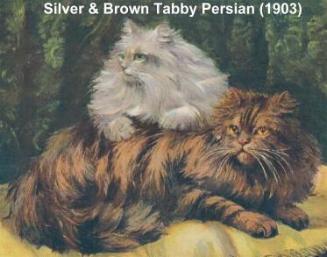
The GCCF studbook of 1925 lists a "sable chinchilla" male called Bracken, whose parents were Caiville (male) and Minetta (female). Bracken appears to have been an early Golden Persian and had a chinchilla female littermate. An influential "silver" (Chinchilla) female, Recompense of Allington, was born from another mating of Caiville to Minetta and there is a 75% probability that Recompense carried the Golden gene which popped up in Chinchilla descendants later on. Evelyn Buckworth-Herne-Soame's 1933 book included a chapter on the Brown Tabby Longhair. She commented on the very successful Brown Tabby Longhair of 1896, Champion Birkdale Ruffie and also on a much later "rich sable colour" cat called Treylstan Garnet and referred to the colour class as "brownies", then the term for the brown tabby (as opposed to "silvers"). In 1927, Mrs Sydney Evans placed her Longhair Sable at stud. The cat was acquired from Mrs Jourdain who knew of several cats of that variety and hoped that they might become better established. All were bred from Chinchilla stock. Sable was excellent in type and had a good sable coat with black tips (called ticking, but not to be confused with the Abyssinian) along the spine and on the tail, head and paws. His eyes were emerald green. Assuming that the "Sable Tabbies" of history were in fact Golden Tabbies, the following descriptions of Sables from around 1903 give an insight into the early history of the golden series.
The 1903 "Book of the Cat" stated: "There is a distinct kind of brown tabby, which may better be described as sable. These cats have not the regular tabby markings, but the two colours are blended one with another, the lighter sable tone predominating. At the Crystal Palace Cat Show of 1902 the class was for brown tabby or sable. I was judging, and, considering the mixed entries, I felt that markings must not be of the first importance, and so awarded first and second to Miss Whitney's beautiful sable females, the third going to a well-marked though out of condition brown tabby. ... These sable marked cats are rare, but still more beautiful would be a cat entirely of the one tawny colour - a self sable, without markings. "The most suitable factors to obtain this colour," so writes Mrs Balding, "would probably be tortoiseshell-and-sable tabby, as free from marking and as red in ground colour as possible. A cross of orange, bright coloured and as nearly as obtainable from unmarked ancestors, would be useful. Some nine years ago I purchased a dimly marked bright sable coloured cat, 'Molly,' shown by Mrs Davies at the Crystal Palace, with a view to producing a self-coloured sable cat; but 'Molly' unfortunately died, and I abandoned the idea. The nearest approach to a self-sable I have ever come across was a cat I obtained for the Viscountess Esher, which had, alas! been neutered. He was almost unmarked, and of the colour of Canadian sable, with golden eyes - a most uncommon specimen."
Frances Simpson wrote: "For sables we, of course, go to the Birkdale strain. I remember the incomparable "Birkdale Ruffie" in his full glory at the Crystal Palace - a mass of red-brown fur, of the style of "Persimmon Laddie," but with more distinct markings and a very keen, almost fierce expression; in fact, he looked like a wild animal! Then "Master Ruffie" appeared as a kitten, and later as a mild edition of his sire. From this celebrated strain Miss Whitney's lovely sables are descended. ... the brown tabby and sable, though often classed together, must not be confounded. The brown tabby is supposed to be the common ancestor of all our cats, and hence the tendency to revert to that colour. ... They appear in very unexpected places - in a litter of chinchillas or blacks, or among our oranges, and sometimes where no brown ancestor can be traced. ... As regards the sables, I may remark that they are late in maturing and do not acquire their marvellous colouring till about the second year ." (She also remarked that sable tortoiseshells existed)
Miss Southam described Birkdale Ruffie in Frances Simpson's The Book of the Cat: It was at the West of England Cat Show in 1894 that 'Birkdale Ruffie' scored his first real success winning two first prizes in the open and novice classes and two specials. Here at last his beautiful sable colouring, his dense black markings, and wonderful expressive face were appreciated. The year 1896 was the occasion of his sensational win at the Crystal Palace show. He simply swept the board, carrying everything before him - first prize, championship, several specials."
Miss Witney wrote "'Brayfort Fina' is, I may say, a sable tabby, being particularly rich in colour all throughout - indeed, more often of an auburn tan than brown. ...'Fina' was bred by Miss G Southam, and is by 'Master Ruffie' ex 'Bluette,' her sire being a son of the famous 'Champion Birkdale Ruffie.' [In 1902 'Fina' took first] at the Bath Specialist Show in the same year, where her gorgeous colouring was called in question and an unsupported protest was made that she was dyed!
Past and Present Genetic Theories for Silvers
.OTHER SILVER-LIKE OR GOLDEN-LIKE COLOURS
Sunshine, Bimetallic And Platinum
For some years, strangely patterned Siberian cats have been turning up. Some resemble tortoiseshell in having both silver regions and golden regions. They couldn t all be chimeras, so there had to be some unidentified mechanism at work. This is described in "Bimetallic" Siberians & Platinum Persians.
Pseudo-Goldens & Late Colour Change "Goldens"
There are accounts of pure silver Persian kittens turning to a pale golden colour as they mature. This appears due to an additional mutation that causes the round eumelanin granules to become elliptical and to appear as a beige or pale golden colour smeared along the hair shaft causing a pale golden undercoat. They are also clumped at the tip to give the shaded or tipped effect. Its mode of inheritance not fully understood. This is described in more detail on Amber and Russet - Late Colour Change Genes.
Amber (Black Modifier) gene, found in Norwegian Forest Cats, brightens black or blue areas of the coat to Amber (apricot-to-cinnamon colour) and Light Amber (pale beige). At birth, kittens appear black or blue, and they brighten to Amber or Light Amber respectively. Amber can occur in conjunction with silver: the kittens are born as poorly coloured black-silver or blue-silver tabbies, but mature into a bright apricot to cinnamon colour with dark brown paw pads and nose leather with no black rim (the black rim is characteristic of agouti silvers).
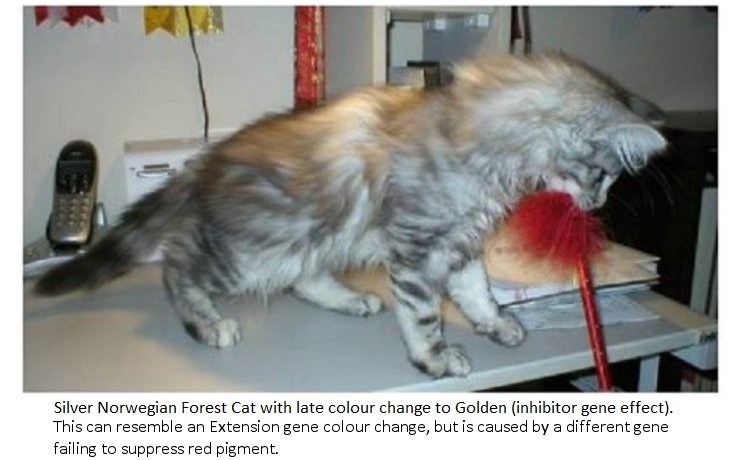
Other colour changes can have a superficial resemblance to extension gene colour changes. This Norwegian Forest Cat was bred by Yve Hamilton Bruce from a silver mackerel tabby female (imported from Denmark) and a classic red tabby and white male. The result was 1 silver tabbies and 2 silver tabbies with white. At just over 3 months old, this silver and white tabby male developed a large patch of bright red hair on his back (as shown) which continued to spread until he was completely golden. Though similar to an amber colour-change, this is an unusual silver-to-golden change related to the inhibitor gene. Though it superficially resembles amber, this particular colour change is related to the inhibitor gene.
UNEXPECTED SILVERS
The phenomenon of a pair of non-silver cats producing silver offspring has been documented several times. Neils C Pedersen, Feline Husbandry, 1991 (pg 67) reported "several cases on record of black cats breeding as smokes." Robinson s Genetics for cat Breeders and Veterinarians, 4th Edition, 1999 (pg 142) reported "occasional cats with no visible white undercoats that nonetheless breed as smokes." Some apparently solid cats are genetically smoke, but either have a very narrow band of silver or the undercolour is darker than usual.
"Recessive silver" has been posited. If it existed, it would be either hypostatic (masked fully or partially by other colour genes) or a recessive allele of the inhibitor gene. It s possible that 2 separately inherited gene pairs (on different loci) interact to produce the visual effect of silver. When inherited separately there may be no visual effect or a different effect e.g. lightening of the coat colour ("powder coat").
In North America some breeders refer to a phenomenon they call "powder coat" and "high colour," but different breeders have different interpretations of powder coat. For some it means a lighter (softer) colour cat while high colour indicates a darker colour. For others, it means the tips of the hairs are lighter, giving the cat a powder-dusted effect. Either way, it is linked to variations in depth of colour and is inherited in a predictable way. In solid-colour cats these variations are generally attributed to polygenes, but in some Burmilla and Burmese lines, powder coats appear linked to unexpected silver offspring (mismating was ruled out) leading some to wonder if powder coat is linked to a hypothetical hypostatic silver gene. See Powder Coat for more information.
Unexpected silver cats occasionally turn up when two golden cats have produced silver offspring, or when a golden mated to a heterozygous silver (silver carrying golden) has consistently produced silver kittens, even though the law of averages would expect half of the offspring to be golden. Perhaps the "golden" cat is really a very tarnished silver due to other genes it inherited alongside the dominant inhibitor (silver) gene.
